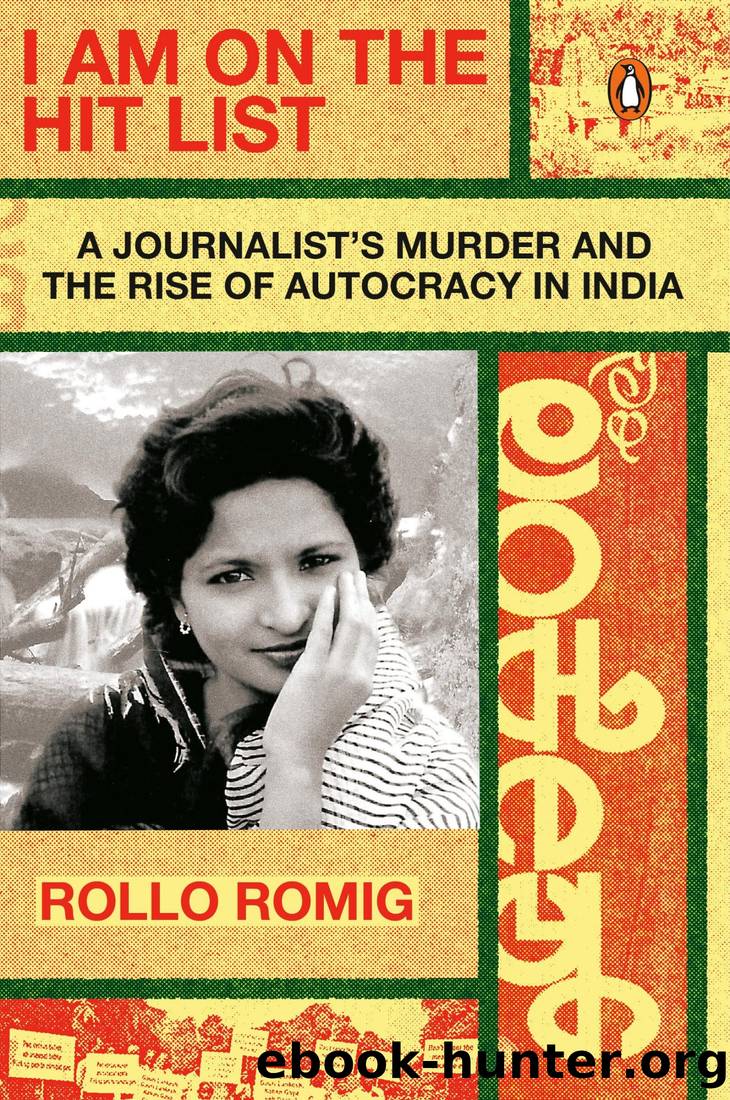I Am on the Hit List: A Journalist's Murder and the Rise of Autocracy in India by Rollo Romig

Author:Rollo Romig [Romig, Rollo]
Language: eng
Format: epub
Tags: True Crime, Murder, General, Political Science, Religion; Politics & State, Biography & Autobiography, Editors; Journalists; Publishers
ISBN: 9780143135289
Google: h4ThEAAAQBAJ
Amazon: 0143135287
Publisher: Penguin
Published: 2024-08-06T00:00:00+00:00
* * *
⢠⢠â¢
HIGH ON A MOUNTAIN RANGE called Baba Budangiri, in central Karnatakaâs Chikmagalur district, there is a shrine in a small cave shrouded by clouds. The mountains are named for Baba Budan, a Muslim Sufi saint who once lived in the shrine. According to one legend, on his return home from taking the hajj pilgrimage to Mecca, Baba Budan exited the Arabian Peninsula with seven raw coffee beans smuggled in his beard, thereby evading the strict export controls that allowed the Arabs to maintain a monopoly on coffee cultivation. Baba Budan planted the beans at home and introduced India to the delights of coffee. But there are so many legends surrounding this cave that itâs impossible to reduce the place to any single uncontradictory spiritual narrative. Some Muslims believe that the shrine began as the home of a direct disciple of Muhammadâs named Hazrat Dada Hayath Meer Khalandar; some Hindus call that same person Dattatreya and believe he was a combined avatar of all three of the paramount gods of Hinduism: Brahma, Shiva, and Vishnu. For centuries, Dada versus Dattatreya wasnât a debate; the blended legends only enhanced the siteâs power for Hindus and Muslims alike.
Inside its tight, dank confines, the cave is crowded with markers of both religions: at one end, several Sufi tombs; at another, a Hindu idol draped with flowers and slathered with mud. The presiding priest is a Muslim who performs traditionally Hindu rituals: lighting the oil lamp, offering puja, blessing each visitor with holy water. The shrineâs official name is Sri Guru Dattatreya Bababudan Swamy Dargahâan amazing mash-up of Hindu and Muslim names and terms.
Hinduism and Islam might look on paper like stark and irreconcilable opposites, but the kind of fusion observable at Baba Budangiri has long been commonplace across India. In Bengal there was Satya Pir, a Muslim holy man whoâs also thought to be an avatar of Vishnu. In Varanasi there was the beloved mystic poet Kabir, whose critiques of both Hinduism and Islam led him to a faith that borrowed from both. In Punjab, Guru Nanak, the founder of the Sikh religion, also took inspiration from both Hindu scriptures and the Quran. But perhaps more than any other region in India, Karnataka proliferates in syncretic sites like Baba Budangiri, where Islam and Hinduism donât just coexist but converge.
So much of the unique beauty of Hinduism throughout its long history flows from its open-mindedness, its dazzling diversity in practice and devotion and interpretation across the subcontinent. Swami Vivekananda famously declared that Hinduism recognizes all religions as true. Once, when referred to as a Hindu, Mohandas Gandhi said, âI am a Hindu, a Muslim, a Christian, a Parsi, a Jewâ; Muhammad Ali Jinnah, the future founder of Pakistan, cracked in response, âOnly a Hindu could say that.â
The religion we call Hinduism is extraordinarily multifarious, especially from region to region. In fact, âHinduâ originated as an outsiderâs word for Indians that became, under the British, a colonial umbrella term for all the
Download
This site does not store any files on its server. We only index and link to content provided by other sites. Please contact the content providers to delete copyright contents if any and email us, we'll remove relevant links or contents immediately.
Hit Refresh by Satya Nadella(9040)
When Breath Becomes Air by Paul Kalanithi(8333)
The Girl Without a Voice by Casey Watson(7824)
A Court of Wings and Ruin by Sarah J. Maas(7653)
Do No Harm Stories of Life, Death and Brain Surgery by Henry Marsh(6891)
Shoe Dog by Phil Knight(5147)
Hunger by Roxane Gay(4869)
The Rules Do Not Apply by Ariel Levy(4866)
A Higher Loyalty: Truth, Lies, and Leadership by James Comey(4851)
Tuesdays with Morrie by Mitch Albom(4695)
Everything Happens for a Reason by Kate Bowler(4680)
The Immortal Life of Henrietta Lacks by Rebecca Skloot(4527)
Millionaire: The Philanderer, Gambler, and Duelist Who Invented Modern Finance by Janet Gleeson(4386)
How to Change Your Mind by Michael Pollan(4292)
All Creatures Great and Small by James Herriot(4233)
The Money Culture by Michael Lewis(4083)
Man and His Symbols by Carl Gustav Jung(4070)
Elon Musk by Ashlee Vance(4033)
Tokyo Vice: An American Reporter on the Police Beat in Japan by Jake Adelstein(3937)
